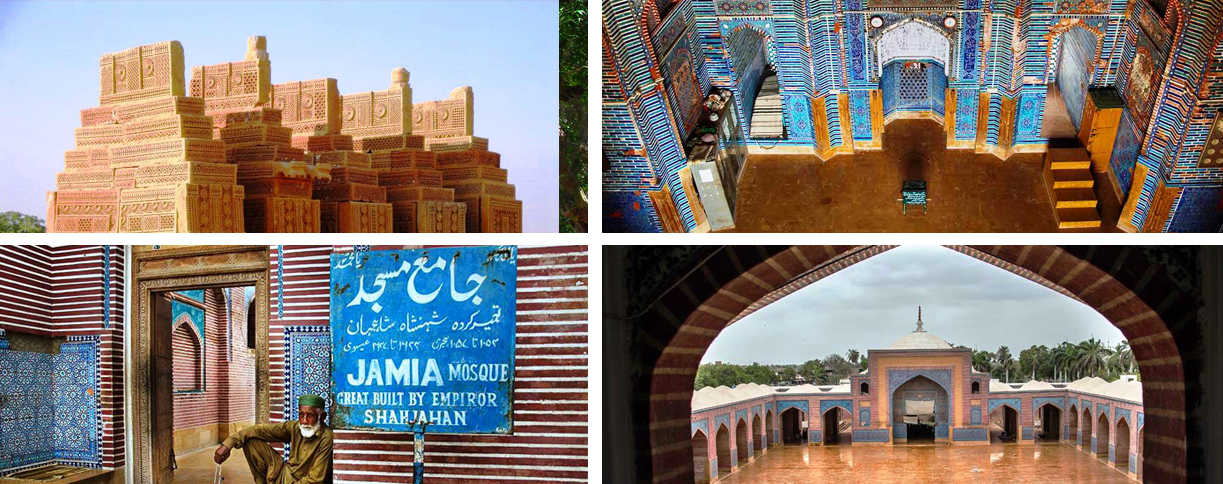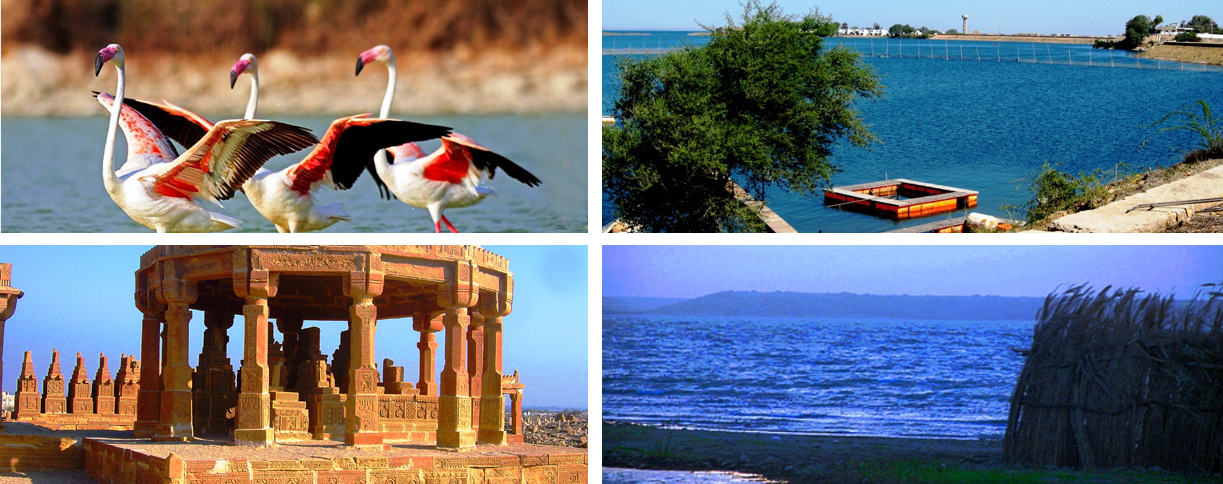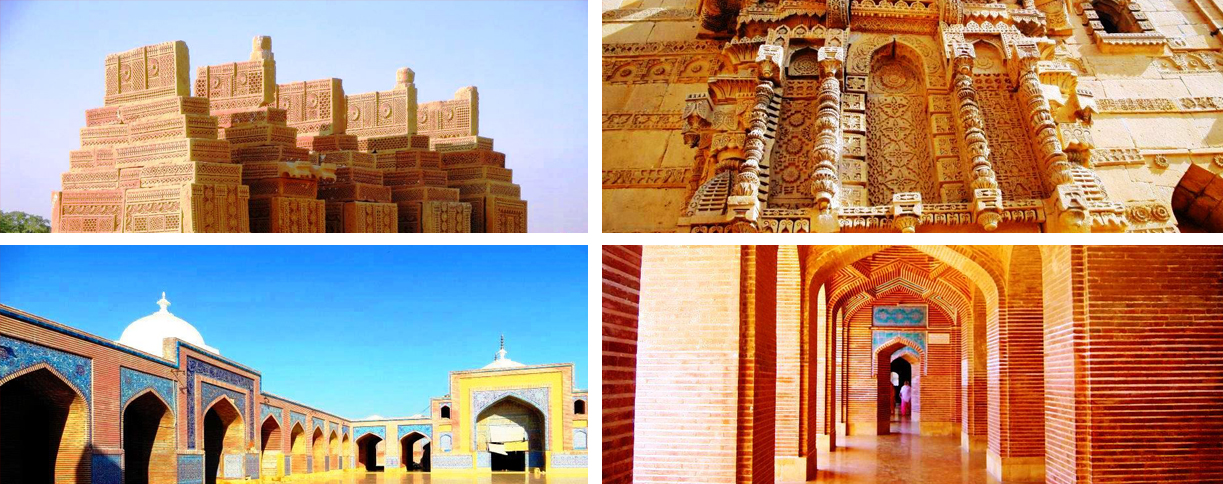Chaukhandi-Bhambore- Makli- Thatta
Chaukhandi
30 minutes away from Karachi lies an astonishing necropolis dating several centuries old called the Chaukhandi Tombs. The word Chaukhandi means ‘four-cornered’ and it takes its name from the complex mausoleums of rich and influential people buried here, which are structurally supported by a column at each of its four sides. These columns usually support a dome or a canopy above the burial place. Hundreds of tombs stretch for nearly 3 kilometres. Another unique thing about these tombs is that they are all oriented in north-south axis. Although a majority of the structures contains graves, there are some pavilion tombs supported by columns as well. Belonging to the sixteenth century, the carvings are similar to those found in the Samma Cluster at Makli necropolis. These tombs belong to the Jokhio, Baloch and Burpat (or Burfat) tribes and most of them date back to between the 13th and 17th centuries. The thing that makes these tombs stand out is the exquisitely carved stone work. This stone work is unique only to certain areas of Sindh and Balochistan.
Bhambore
Associated with the story of Sassui Punhun that was immortalised in the poetry of Shah Abdul Latif Bhittai, the ancient city of Bhambore is situated 37 miles north of Karachi, near Gharo. The 10th century capital of Bhambor, Raja, reached the height of its fame as the most important crossroad of the ancient trade route to China and the Middle East. It is believed that Bhambore was destroyed around 1250 AD, but it still lives in the world of romance and folklore. Nevertheless, the origin and history of Bhambore is mostly obscure and its location controversial. Notwithstanding, there is no factual evidence that proves whether the city of Bhambore really existed or is just a fantasy. No one could find the traces of this place or its name from any authentic historical source. It might be possible that this city existed during an earlier time and was adopted in folklore later; however this theory does not have a strong footing. It is believed that Bhambore, which is 35km from the open sea today, was only 20km from the sea during the 13th century, and when Alexander came here in 324 BC, it was probably on the sea itself or a mile or two inland on the Kalri branch of the Indus. The ancient fort existed before the Arab conquest but was repaired periodically.

Makli
Located near the apex of the delta of the Indus River in Pakistan’s southern province of Sindh is an enormous cemetery, possessing half a million tombs and graves in an area of about 10 square kilometres. Massed at the edge of the 6.5 kilometre long plateau of Makli Hill, the necropolis of Makli – which was associated with the nearby city of Thatta, once a capital and centre of Islamic culture, – testifies in an outstanding manner to the civilisations of Sindh from the 14th to the 18th centuries. The vast necropolis of Makli is among the largest in the world. Kings, queens, governors, saints, scholars, and philosophers are all buried here in brick or stone monuments, some of which are lavishly decorated with glazed tiles. The unique assemblage of massive structures presents an impressive order of monumental buildings in different architectural styles. These structures are notable for their fusion of diverse influences into a local style. The historical monuments at the necropolis of Makli stand as eloquent testimonies to the social and political history of the Sindh.
Thatta
Thatta is an ancient city of the Indus delta with great historical importance and today is famous for its archaeological sites and centuries old monuments. According to historians Thatta may have been the main port on the Indus during the time of Alexander the Great’s invasion. The river Indus has changed its course many times since the days of Alexander, and this ancient site of Patala has been subject to much conjecture (the river changes course slowly due to a process called siltation which is essentially water pollution by fine silt particles).
Thatta was the capital of three successive dynasties, the traces of which are evident in the Makli necropolis, which spreads over a twelve square kilometre area. The most famous of these sites is the Makli Hill, which is the biggest necropolis in the world and located approximately three kilometres from Thatta. Due to its cultural and archaeological importance in the 1980s UNESCO listed the Makli necropolis as a World Heritage Site. The most famous example of Mughal architecture is the Shah Jahan Mosque, constructed in the latter half of the seventeenth century. Thatta played an important role in the history of Sindh and the city was constantly renovated from the 14th to 18th century. But in 1739, when the province of Sindh was taken over by Nadir Shah of Persia, Thatta entered a period of decline. However, the four centuries that comprise the golden age of Thatta have left their traces in the form of several unique monuments in the region.

Haleji Lake
Initially Haleji Lake was a small lake, but during World War II the then British Government of Sindh decided to increase its capacity by introducing a feeder canal from the River Sindh. The work was placed on a war footing and was completed within 24 months. During the war, thousands of American and British troops were stationed in Karachi and their water supply was provided by Haleji Lake. Haleji originally was a salt-water lake which was formed by seasonal water, collecting in a depression but due to greater need of fresh water the salt water was drained out and an embankment was constructed around the lake which was fed by fresh water through a canal. As a result Haleji became one of the major sources for fresh water to the increasing population of Karachi as well as an exquisite refuge for waterfowl.
1 Day Excursion
Chaukhandi, Bhambore, Thatta and Makli
Leisure, Family, Nature/Eco, History , Educational

Trip Itinerary
Chaukhandi, Bhambore, Thatta and Makli
- Drive from Karachi to Chaukhandi and Bhambore
- Continue for Thatta with a visit to the Shah Jahan Mosque and Makli Tombs
- Drive back to Karachi via Haleji Lake
